Commercial metal roof installation: 10 Powerful Benefits 2025
Why Commercial Metal Roofing Makes Business Sense
Commercial metal roof installation is a strategic investment that can transform your building’s performance, appearance, and long-term operating costs. If you’re researching commercial metal roofing options, here’s what you need to know:
Commercial Metal Roof Installation: Key Facts
- Lifespan: 25-60 years (vs. 15-20 years for traditional roofing)
- Energy Savings: Can reduce cooling costs by up to 40%
- Weight: 50-150 lbs per square (vs. 750-900 lbs for concrete/tile)
- Wind Resistance: Can withstand winds up to 140 mph
- Fire Safety: Non-combustible and highly fire-resistant
- Maintenance: Minimal requirements, saving long-term costs
- Installation Time: Typically faster than traditional roofing systems
Metal roofing has become the preferred choice for about one-third of all commercial buildings nationwide, with even higher adoption rates in coastal areas. This popularity isn’t surprising given its exceptional combination of durability, energy efficiency, and aesthetic versatility.
Unlike traditional roofing materials that require replacement every 12-20 years, a properly installed commercial metal roof can protect your facility for decades with minimal maintenance. The initial investment is quickly offset by reduced energy consumption, lower insurance premiums, and virtually eliminated replacement costs.
Modern commercial metal roofing systems come in various profiles, materials, and finishes to match any architectural style. From standing seam panels that offer sleek, clean lines to exposed fastener systems that maximize cost-efficiency, there’s a metal roofing solution for every commercial application.
I’m Adam Kadziola from DML USA Metal Roofing, where we’ve been manufacturing high-quality metal roofing systems since 2007 and have overseen countless commercial metal roof installation projects throughout Illinois and beyond. My experience has shown that businesses consistently benefit from the long-term performance and value that properly installed metal roofing delivers.
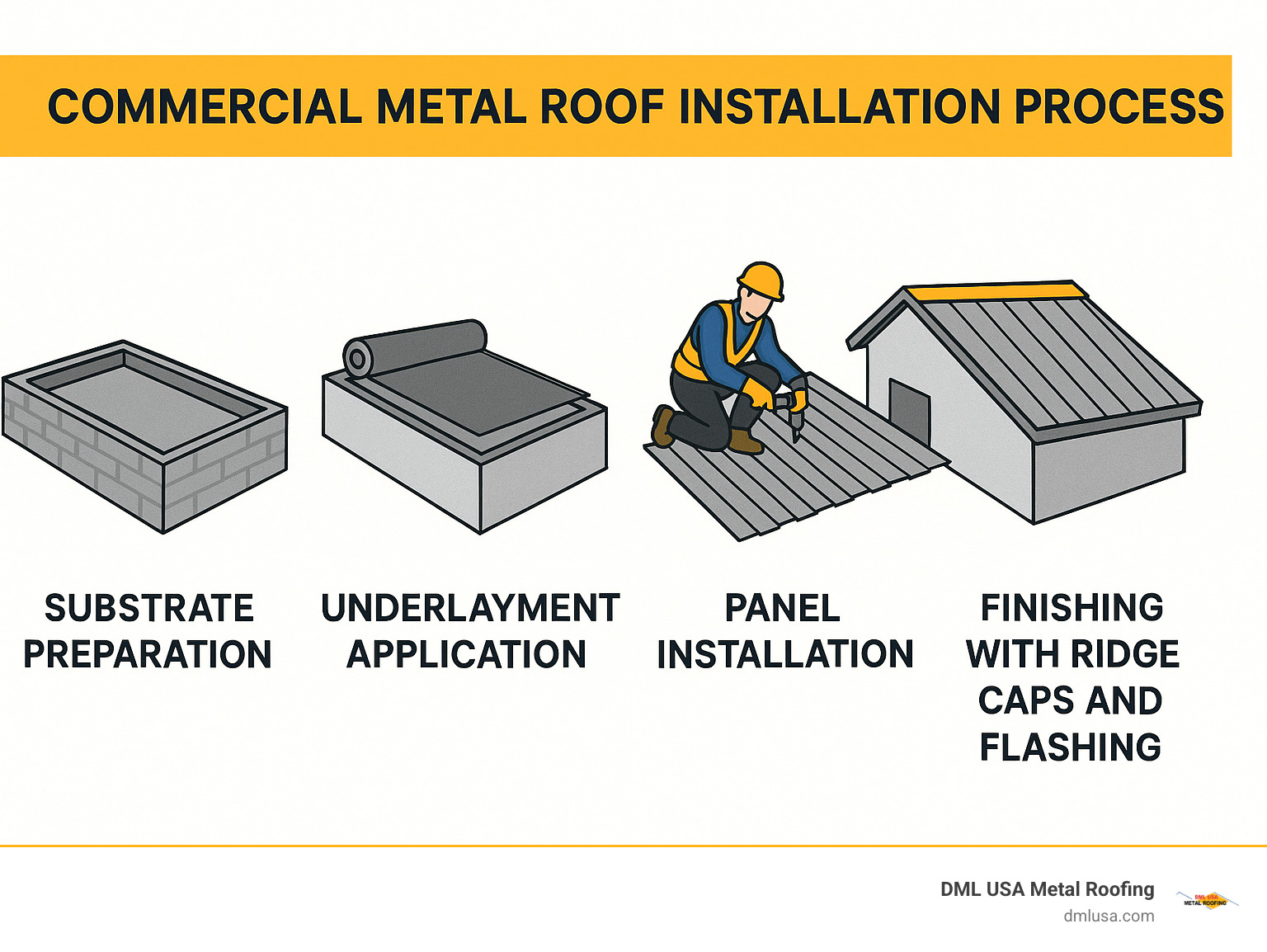
Commercial Metal Roof Installation: Core Concepts & Materials
Let’s explore commercial metal roof installation. It’s more than just slapping some panels on top of your building—it’s about creating a complete system that works together to protect your investment for decades to come.
When you choose a metal roof for your commercial building, you’re investing in an integrated system of panels, underlayment, fasteners, clips, flashing, and sealants that work in harmony. This system isn’t just about looking good (though it certainly does that too); it’s designed to shed water effectively, stand strong against powerful winds, and maintain its integrity through whatever Mother Nature throws at it.
What Is Commercial Metal Roof Installation vs Residential?
While they might seem similar at first glance, commercial and residential metal roofing are different beasts entirely. As one contractor with over 20 years of experience told us, “The biggest mistake I see is treating a commercial installation like a large residential job. The engineering requirements, code compliance, and water management strategies are completely different worlds.”
Commercial projects typically cover much larger areas—think warehouses and shopping centers rather than single-family homes. This difference in scale means commercial installations often require special equipment just to move materials around safely.
Many commercial buildings also feature low-slope or nearly flat roofs (sometimes as little as a ¼:12 pitch), which demands specific panel types and seaming methods to prevent leaks. The structural considerations are different too, with commercial buildings needing to account for wider spans, heavier loads, and often large rooftop HVAC systems.
Perhaps most importantly, commercial buildings face stricter code requirements. These buildings need to meet more rigorous standards for fire resistance, wind uplift resistance, and energy efficiency—all of which influence the installation process.
Main Types of Commercial Metal Roofing Systems
When it comes to commercial metal roof installation, you have several excellent options to choose from:
Standing Seam Systems are the premium choice for many commercial buildings. These panels connect at raised seams that keep water away from the fasteners and create clean, distinctive lines that many building owners love. They come in two main varieties:
Snap-Lock Panels feature male and female legs that simply snap together, making installation relatively straightforward. They work best on roofs with a slope of 3:12 or greater.
Mechanically Seamed Panels require a special seaming tool to create weather-tight connections. They’re ideal for low-slope applications and areas that see extreme weather conditions. When properly installed, these create an incredibly durable roof system.
Exposed Fastener Systems offer a more economical option without sacrificing quality. Traditional corrugated panels provide that classic wavy profile that’s economical and quick to install, while R-Panels feature raised ribs with flat areas between them for greater strength and improved water runoff.
Retrofit/Recover Systems allow you to install new metal roofing over existing roofs without a complete tear-off, saving time and reducing landfill waste.
Insulated Metal Panels (IMPs) bring together structural performance and thermal efficiency in one product. These factory-assembled panels combine metal facings with an insulating foam core, providing excellent energy performance.
Each system has its sweet spot. A warehouse in rural Illinois might benefit from a different system than a retail store in Chicago’s urban core. At DML USA Metal Roofing, we can help you steer these choices to find the perfect fit for your specific building needs.
Most Common Roofing Metals & Coatings
The backbone of any commercial metal roof installation is the material itself. Your choice of metal and coating will significantly impact how long your roof lasts and how it performs over time.

Galvanized Steel offers good corrosion resistance at a budget-friendly price point. It’s steel coated with a protective layer of zinc that sacrifices itself slowly over time to protect the steel underneath.
Galvalume® takes protection a step further by coating steel with a 55% aluminum-zinc alloy. This provides superior corrosion resistance compared to standard galvanized steel, typically lasting 25+ years even in challenging environments.
Aluminum is naturally resistant to corrosion, making it ideal for coastal areas where salt spray is a concern. It comes at a higher price point than steel options but can be worth the investment in the right location.
For those seeking the ultimate in longevity, Copper and Zinc roofs are hard to beat. Copper can last 200+ years and develops a beautiful green patina over time, while zinc develops its own protective patina and can last 80-100 years when properly installed. Both come at premium price points but offer best durability.
The coating system applied to your metal roof is just as important as the base metal. PVDF (Kynar 500®) is considered the gold standard, offering superior color retention, chalk resistance, and longevity of 25-35 years. Silicone-Modified Polyester (SMP) offers good performance at a lower cost, making it a popular middle-tier option.
For energy efficiency, Cool Roof Coatings are specially formulated to reflect solar energy, reducing cooling costs and helping combat urban heat island effects.
“In our experience at DML USA Metal Roofing,” notes our lead engineer, “Galvalume® steel with a PVDF coating offers the best value proposition for most commercial applications in the Illinois climate, providing excellent corrosion resistance and color stability while remaining cost-effective.”
We invite you to explore our Resources section for more detailed information about metal types, coatings, and how to choose the right combination for your specific project needs.
Business Value: Benefits, Lifespan & Sustainability
When investing in a commercial metal roof installation, you’re getting much more than just a cover for your building. You’re making a smart business decision that pays dividends for decades to come.
Key Benefits for Facility Owners
A metal roof transforms your facility in ways that directly impact your bottom line. The exceptional durability of these systems means your roof can withstand punishment that would destroy conventional roofing materials. Heavy winds up to 140 mph? No problem. Hailstorms? Metal roofs often carry Class 4 impact ratings, the highest available. Fire concerns? Metal is naturally non-combustible, earning Class A fire ratings.
Beyond protection from the elements, metal roofing is remarkably lightweight. At just 50-150 pounds per square (100 square feet), these systems put far less stress on your building’s structure compared to tile or concrete alternatives that can weigh a whopping 750-900 pounds per square. This weight advantage makes metal perfect for both new construction and retrofit projects.
“After installing our metal roof system, we saw a 15% reduction in our annual insurance premiums, which significantly improved our ROI calculations,” shared one Chicago facility manager we worked with. Many insurance companies recognize the superior protection metal roofs provide and offer substantial premium discounts as a result.
Your time matters too. Metal roofing typically installs faster than built-up or single-ply membrane systems, meaning less disruption to your operations and reduced labor costs. This quicker installation also minimizes the time your building is exposed to weather during the roofing process.
Lifespan & Warranty Expectations
The longevity of a properly installed commercial metal roof creates remarkable life-cycle value. While conventional commercial roofing might need complete replacement every 15-20 years, metal roofing systems deliver 25-60+ years of reliable service, depending on the specific system, material, and environment.
This exceptional lifespan is backed by substantial warranties. Premium PVDF coatings typically carry 25-35 year finish warranties, protecting against fading, chalking, and peeling. Weathertightness warranties range from 5-20 years depending on the system and installer qualifications. Material warranties often extend 20+ years against manufacturing defects.
As one building owner in Chicago told us, “We’ve replaced our flat rubber membrane roof three times in the 30 years we’ve owned the building. The metal roof on our newer facility hasn’t needed anything but routine maintenance in 25 years.”
Energy Efficiency & Green Building Credits
Today’s commercial metal roof installation options deliver impressive energy performance. Light-colored and specially coated “cool roof” systems can reflect up to 70% of solar radiation, dramatically reducing heat transfer into your building. Unlike some materials that absorb and hold heat, metal quickly releases absorbed heat rather than transferring it inside.
Many metal roof systems create natural Above Sheathing Ventilation (ASV), forming an air gap between the roof and deck that provides additional insulation. These systems also easily accommodate extra insulation during installation, enhancing their thermal performance.
These properties translate to real-world savings: cooling energy reductions of 10-25% (up to 40% in some cases), lower peak cooling demand, and decreased urban heat island effect. Your metal roof might also help you earn valuable LEED points and meet increasingly stringent energy codes.
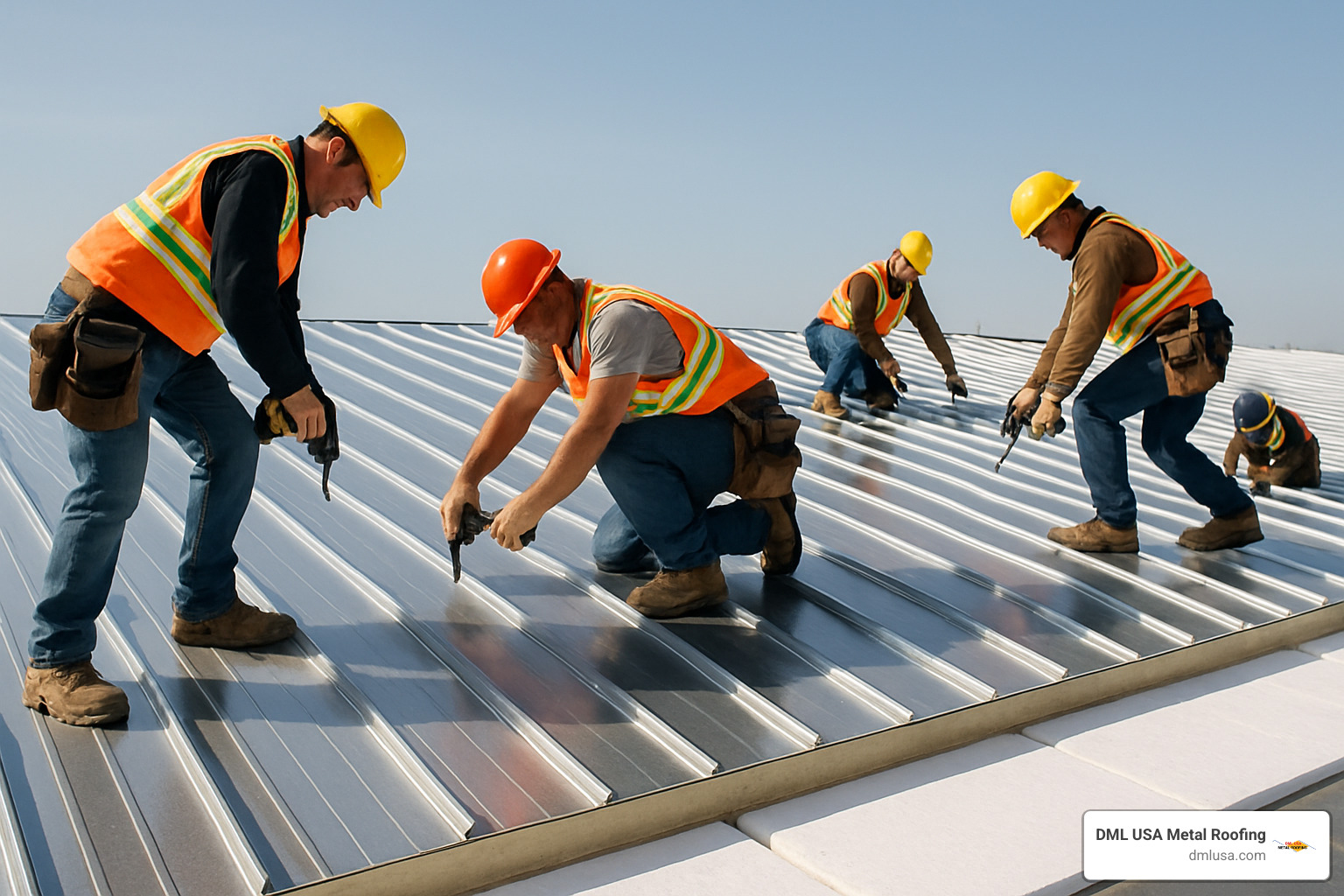
The sustainability story gets even better. Metal roofing typically contains 25-95% recycled content and is 100% recyclable at the end of its service life. When it’s eventually time for a replacement (likely decades down the road), your old metal roof won’t contribute to landfill waste. Many metal roofing projects also qualify for various energy tax credits, further improving your return on investment.
For more information on these benefits and how they compare to traditional options, check out this resource on metal roofs vs. standard asphalt shingles or explore why choose metal roofing for your next project.
The Installation Journey: From Prep to Final Inspection
Every successful commercial metal roof installation tells a story – one that begins long before the first panel goes up and continues until the final inspection. Let me walk you through this journey so you’ll know exactly what to expect when you decide to upgrade your facility.
Pre-Installation Assessment & Code Checks
The foundation of a great metal roof starts with thorough homework. Think of this phase as the detective work that prevents future headaches.
When our team at DML USA approaches a new project, we first examine your building’s unique characteristics. We’ll check your roof deck’s condition, verify it can handle the new system, and identify any quirky spots like equipment penetrations or unusual architectural features.
“The quality of a metal roof installation is determined before the first panel goes up,” one of our project managers often says. “Proper assessment and planning prevent 90% of potential issues.”
Next comes the paperwork dance – ensuring compliance with local building codes, confirming the proper wind uplift ratings for your location, verifying fire resistance requirements, and securing all necessary permits. We’ll also make sure your new roof will meet energy codes, potentially saving you money for decades to come.
Finally, we develop a practical game plan: where to stage materials, how crews will access the roof, what safety systems we’ll implement, and how to work around weather forecasts. For occupied buildings, we’ll coordinate closely with your operations team to minimize disruptions to your business.
Step-by-Step Commercial Metal Roof Installation Process
Once the preparation is complete, the change begins. While each project has its unique elements, here’s what typically happens when we install your commercial metal roof:
First, we prepare your roof deck, ensuring it’s clean, properly secured, and ready to serve as the foundation for your new system. For retrofit projects, we address any existing issues like moisture damage before proceeding.
Next comes the underlayment – a critical but often overlooked component. This high-temperature synthetic layer provides an extra weather barrier beneath your metal panels. We pay special attention to vulnerable areas like eaves and valleys, where we install additional protection against ice and water infiltration.
Before the main panels go up, we install the preliminary trim and flashing components that will guide water off your roof. These include eave trim, valley flashing, and drip edges – all essential for proper water management.
Then comes the main event – panel installation. Whether we’re using a standing seam system with clips or an exposed fastener design, we’ll start at the strategically correct position (often based on prevailing winds) and maintain precise alignment throughout. Each panel must be perfectly squared with your structure and maintain consistent overlaps with adjacent panels.
For standing seam systems, we’ll mechanically seam the panels together using specialized equipment. With exposed fastener systems, we’ll secure each panel with precisely torqued fasteners to prevent both leaks and dimpling.
The detail work follows – installing ridge caps, completing flashings around all penetrations, sealing critical junctions, and connecting your drainage system. This is where craftsmanship really shines, as these details determine both the appearance and weathertight integrity of your roof.
Finally, we conduct a thorough inspection, checking every fastener, seam, and detail. We’ll verify proper drainage and remove all debris, including metal shavings that could cause premature rusting if left behind.
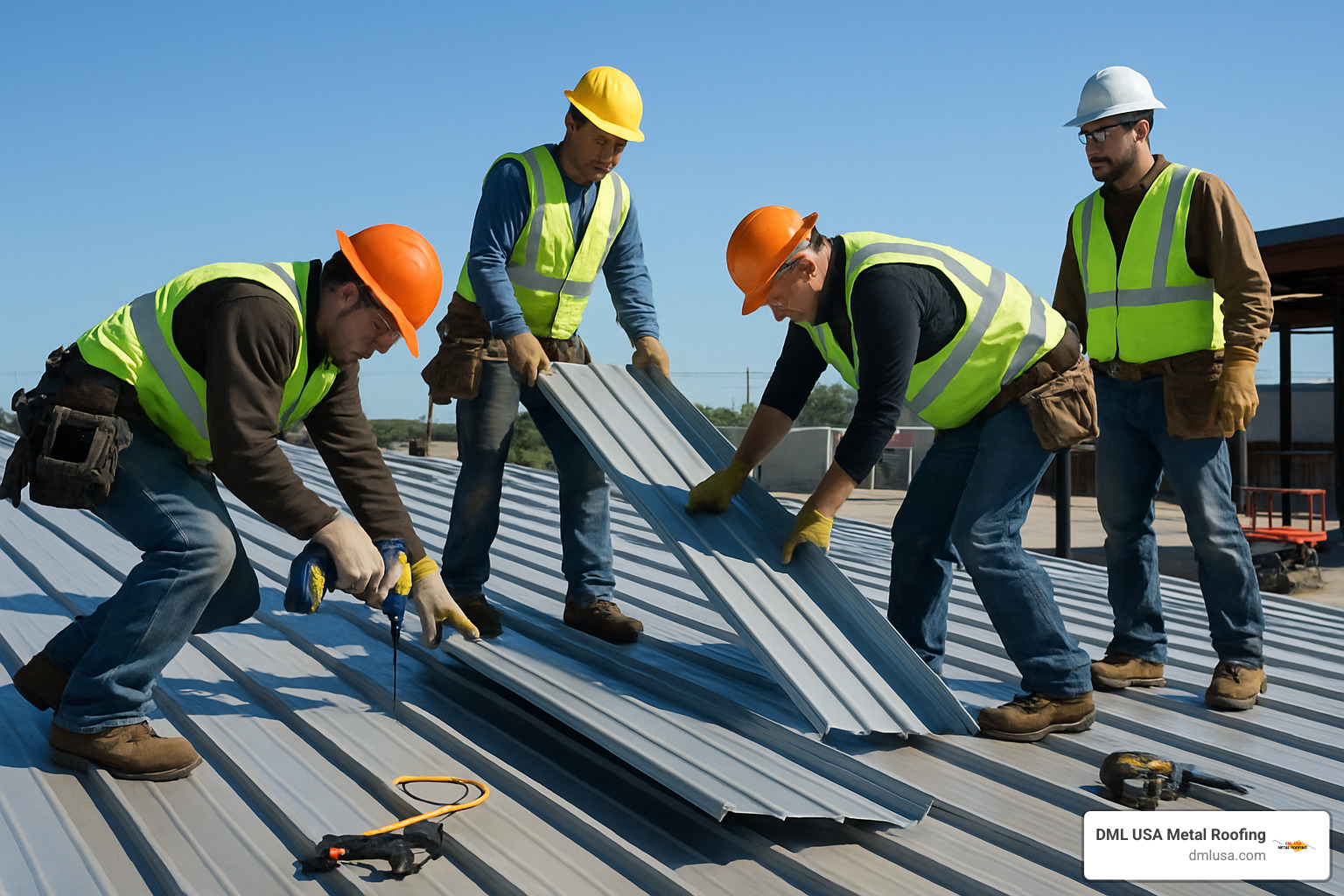
Ensuring Weatherproofing, Wind & Fire Resistance
What separates an average installation from an excellent one? It’s the attention to details that protect your building against the elements.
For weatherproofing, we focus on the critical junctions where water could potentially enter. This means getting the panel overlaps just right (typically ½-¾ inch), applying sealants and butyl tape at the precise locations, and installing closure strips that block wind-driven rain at ridges and eaves. We also pay careful attention to flashing details around roof penetrations and orient all overlaps to work with, not against, prevailing winds.
Wind resistance comes from proper engineering and execution. We install fasteners or clips in patterns specifically engineered for your building’s wind zone requirements. We give extra attention to corners and perimeter zones where wind forces are highest. For standing seam systems, we ensure seams are properly formed to achieve their rated wind resistance.
Fire resistance might not be top of mind when you think about metal roofing, but proper installation includes fire-rated underlayments when required by code, correct detailing around potential heat sources like HVAC equipment, and maintenance of required fire breaks and separations.
Safety Considerations During Commercial Metal Roof Installation
At DML USA Metal Roofing, we believe no roof is worth an injury. That’s why safety isn’t just a checklist for us – it’s a culture.
Our crews use comprehensive fall protection systems including personal arrest equipment, guardrails, safety monitoring, and warning lines. We’ve developed specific protocols for safely handling large metal panels, which can become dangerous in windy conditions if not properly secured.
Our tools and equipment undergo regular inspection and maintenance, with proper grounding of all electrical equipment and appropriate guards and safety features in place. We also monitor weather conditions closely, with clear guidelines on wind speed limitations, lightning safety, and temperature-related precautions.
“We emphasize that there’s no compromise on safety,” our safety director often reminds our teams. “Even routine tasks can present hazards when performed at height or with specialized equipment.”
By following these proven processes, we ensure your commercial metal roof installation not only meets but exceeds expectations – delivering the decades of trouble-free performance and energy savings that make metal roofing such a smart investment for your facility.
Post-Installation Success: Codes, Costs, Contractors, Maintenance & FAQs
Your commercial metal roof installation isn’t just a project—it’s a long-term investment in your building’s future. Understanding what comes next helps you maximize returns and ensure decades of worry-free protection.
Building Codes, Permits & Regulations Checklist
Navigating the regulatory landscape doesn’t have to be intimidating, but it does require attention to detail:
The International Building Code (IBC) sets the foundation for commercial roofing requirements, though your local building department likely has specific amendments that modify these national standards. Most commercial buildings must meet a minimum roof slope of ¼:12 per IBC, though for optimal performance, many manufacturers (including us at DML USA) recommend at least ½:12 pitch.
Beyond basic building codes, your project may need to satisfy FM Global insurance requirements, which often exceed minimum code standards. Energy codes like ASHRAE 90.1 increasingly impact roofing choices, especially in states with aggressive climate goals. And if you’re in an area with high winds, heavy snow loads, or seismic activity, expect additional special zone requirements to protect your building.
“I always tell clients to have a coffee with their building official early in the process,” says our permit specialist Tom. “Understanding requirements upfront saves headaches later. One hour at the building department can prevent weeks of project delays.”
Budgeting & Cost Factors You Should Know
When budgeting for your commercial metal roof installation, several key factors influence the bottom line:
Material choices make a significant impact—steel is generally more economical than aluminum, copper or zinc, while standing seam systems typically cost more than exposed fastener panels. The coating quality matters too; premium PVDF finishes like Kynar 500® cost more upfront but typically last twice as long as standard SMP coatings.
Installation complexity drives labor costs. A simple rectangular warehouse is more economical to roof than a building with multiple levels, numerous penetrations, or limited access. Regional labor rates vary considerably too—the same roof might cost 30% more in Chicago than in rural Illinois.
Project-specific factors like structural modifications, code-required upgrades, or specialized insulation needs can significantly impact your budget. While costs typically range from $7-15 per square foot installed, premium systems can exceed $20 per square foot.
That might sound substantial compared to conventional roofing, but here’s the perspective that matters: When amortized over a metal roof’s 50+ year lifespan, the annual cost is often significantly lower than traditional roofing systems that require replacement every 15-20 years.
As our estimator likes to say, “The sweet spot isn’t the cheapest roof—it’s the one that delivers the best value over its lifetime.”
Can You Install a Metal Roof Over an Existing Commercial Roof?
One of the most practical advantages of commercial metal roof installation is the ability to install over existing roofing in many situations. These “retrofit” or “recover” systems offer compelling benefits:
You’ll eliminate tear-off costs and the associated business disruption—no need to close operations while roofers strip away old materials. This approach also reduces landfill waste significantly, keeping tons of material out of overburdened disposal sites. The existing roof remains in place during installation, maintaining weather protection throughout the process.
Perhaps most appealing is the opportunity to add insulation between the old and new roof, improving energy efficiency dramatically. Many building owners report saving up to 25% on project costs compared to complete tear-off.
Not every building is a candidate, however. Most building codes limit structures to a maximum of two roof layers. The structural capacity must be sufficient to support the additional weight, though metal roofing’s lightweight nature makes this less concerning than with other materials. Any severe moisture issues in the existing roof must be addressed before proceeding.
“One of our most successful projects was a 75,000 square foot warehouse in Northlake,” shares Mike, our project manager. “We installed a complete metal retrofit system over a failing built-up roof without disrupting their operations. Five years later, they’ve recouped nearly 40% of the project cost through energy savings alone.”
Selecting & Vetting the Right Roofing Contractor
The quality of your commercial metal roof installation ultimately depends on who installs it. Even the finest materials can fail prematurely in the hands of inexperienced installers.
Start by verifying proper licensing for commercial work in your jurisdiction. Ensure they carry comprehensive insurance including both liability and workers’ compensation coverage—ask for certificates naming your company as an additional insured. Look for contractors with manufacturer certification for the specific system you’re considering; these credentials indicate specialized training.
Review their portfolio of similar projects and don’t just take their word for it—speak with past clients about their experience. Was the project completed on time and within budget? How did the contractor handle unexpected challenges? Were they responsive to concerns?
Check their standing with licensing boards and the Better Business Bureau. A contractor’s safety record speaks volumes about their professionalism—request their EMR (Experience Modification Rate) to compare against industry averages.
“The most telling question I recommend asking,” says our training manager, “is how long their average employee has been with the company. Stable crews who’ve worked together for years typically deliver better results than constantly changing teams.”
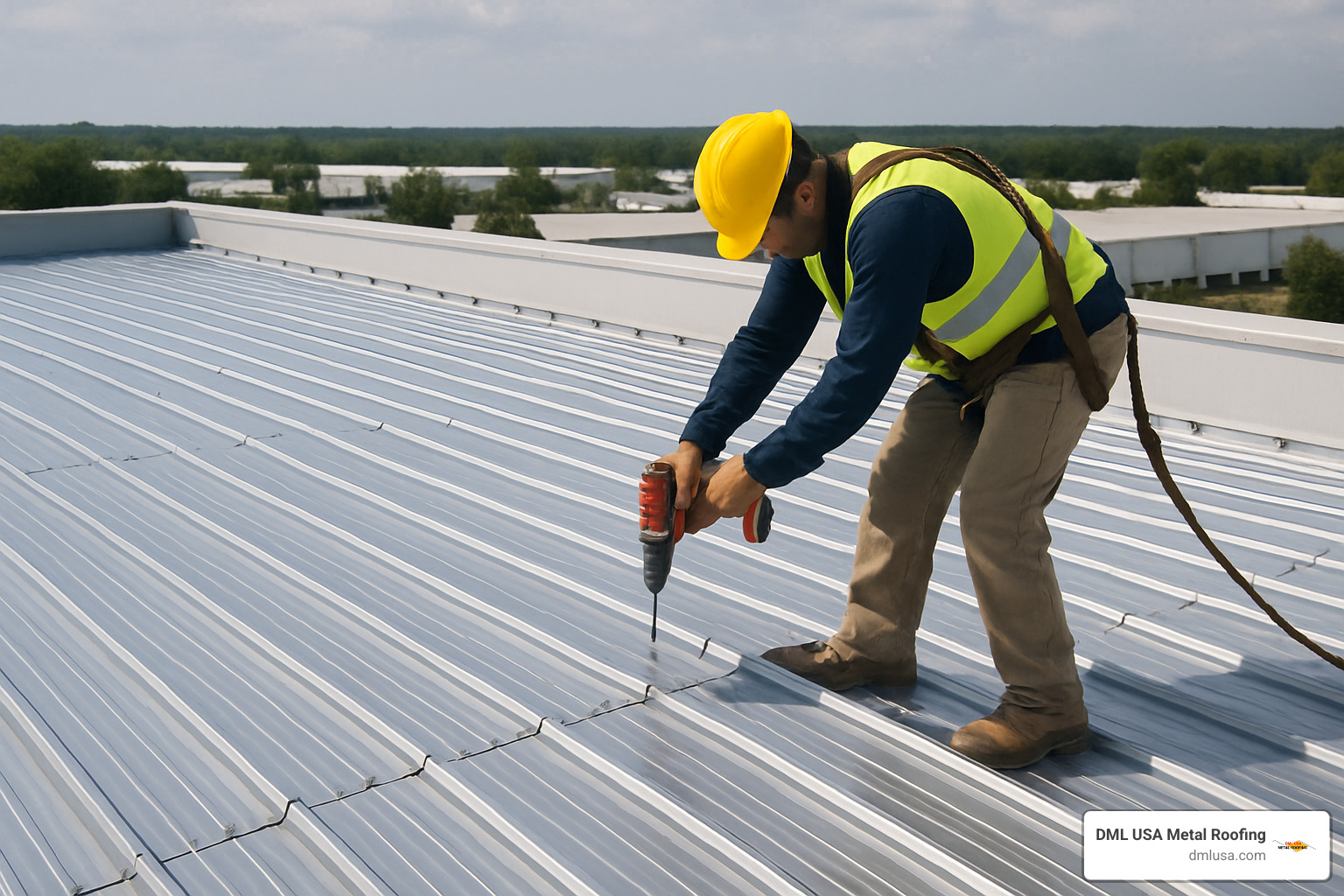
Maintenance, Repairs & Restoration Best Practices
While metal roofing is famously low-maintenance, a small investment in regular care pays big dividends in extended service life.
Mark your calendar for semi-annual visual inspections in spring and fall. These quick check-ups focus on removing debris from the roof surface and gutters, inspecting flashings and penetrations, checking for loose fasteners, and examining sealants for deterioration. Most building maintenance staff can handle these inspections, though professional assessments every 2-3 years provide extra peace of mind.
Even the best roofs occasionally need attention. On exposed fastener systems, fastener replacement may be needed every 15-20 years as gaskets age. Sealants at penetrations typically need renewal every 7-10 years. Minor damage from falling branches or maintenance traffic can usually be addressed with simple repairs rather than panel replacement.
As your roof ages, restoration options can extend its service life. Specialized roof coatings can refresh weathered finishes, while retrofit insulation systems can improve energy performance on older installations.
“The best maintenance program is the one you’ll actually follow,” suggests Sarah, our service manager. “Keep it simple, document what you find, and address small issues before they become big problems.”
Design, Color & Curb Appeal Options
Today’s commercial metal roof installation options go far beyond the utilitarian silver roofs of decades past. Modern metal roofing offers extensive aesthetic possibilities to complement your building’s architecture and your brand identity.
Standard PVDF color palettes typically include 20-30 options ranging from subtle earth tones to bold statement colors. Need to match your corporate colors exactly? Custom color matching capabilities ensure brand consistency across all your facilities. For distinctive appearances, consider premium metallic and prismatic finishes that change appearance as lighting conditions shift throughout the day.
Beyond color, the panel profile significantly impacts visual appeal. Vertical seam spacing (typically 12″-24″), seam height variations (1″-2.5″), and panel surface textures (striated, pencil rib, or smooth) all contribute to the roof’s appearance. Some systems even offer curved or tapered panel capabilities for distinctive architectural expressions.
For comprehensive design integration, consider complementary wall panel systems, coordinated soffit and fascia components, or custom fabricated details that tie the entire building envelope together visually.
“Metal roofing offers a unique opportunity to make your building distinctive,” notes Rachel, our design consultant. “The right profile and color selection can transform a utilitarian structure into an architectural statement that reinforces your brand every time someone sees your building.”
Frequently Asked Questions about Commercial Metal Roof Installation
How long does a commercial metal roof last?
Most commercial metal roof installations deliver 25-60 years of service, depending on the material, coating, environment, and maintenance. Premium systems with proper care can exceed 60 years—potentially the last roof your building will ever need.
Do metal roofs make buildings hotter?
Quite the opposite! Modern metal roofs with reflective coatings actually reduce heat gain significantly. Light-colored and specially coated “cool roof” systems can reflect up to 70% of solar radiation, dramatically reducing cooling costs in summer months.
What warranties are available for commercial metal roofing?
Typical warranties include finish warranties (25-35 years), weathertightness warranties (5-20 years), and material warranties (20+ years). At DML USA Metal Roofing, we stand behind our products with some of the industry’s strongest warranty protection.
Are metal roofs noisy during rain?
This common misconception comes from older agricultural buildings with metal installed directly over open framing. Properly installed commercial systems with solid decking and insulation are no noisier than other roofing types—in fact, many building owners report improved acoustic performance after upgrading to metal.
Can a metal roof support solar panels?
Absolutely! Standing seam metal roofs are ideal solar panel platforms. Special clamp systems attach directly to the seams without penetrating the roof surface, eliminating leak risks while positioning your business to capture renewable energy benefits.
How do metal roofs perform in extreme weather?
Commercial metal roofing systems excel in challenging conditions. They can withstand winds up to 140 mph, resist hail damage better than conventional roofing, shed snow effectively to prevent dangerous accumulation, and provide non-combustible protection against fire threats.
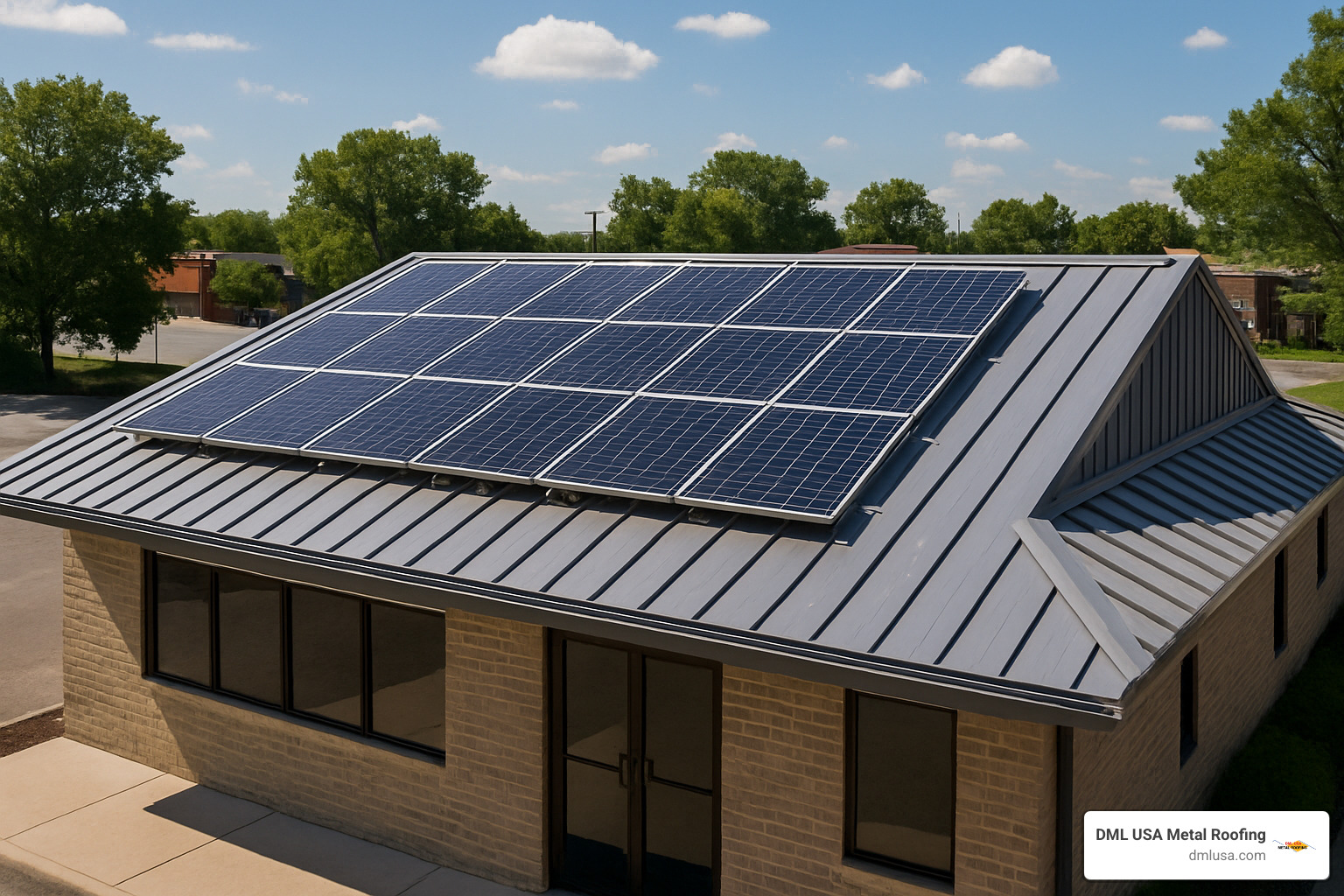
Conclusion
Commercial metal roof installation represents one of the most significant long-term investments you can make in your facility’s performance and protection. I’ve seen how a quality metal roof transforms buildings – not just in appearance, but in overall functionality and operational costs.
The numbers tell a compelling story. With exceptional longevity of 25-60 years (compared to 15-20 for traditional roofing), minimal maintenance requirements, and energy efficiency that can cut cooling costs by up to 40%, metal roofing creates impressive value for virtually any commercial building. Add in the sustainability benefits of recyclable materials and potential for LEED credits, and the case becomes even stronger.
At DML USA Metal Roofing, we’ve watched our Illinois-made panels transform commercial buildings throughout Chicago and beyond. Being manufactured right here in Northlake gives us a unique advantage – we understand the specific challenges Midwest buildings face, from heavy snow loads to dramatic temperature swings.
Whether you’re planning a new facility or upgrading an existing roof, the performance advantages of metal roofing deliver real-world returns that improve your bottom line. Energy savings through superior reflectivity, lower maintenance expenses compared to conventional roofing, and an extended service life that minimizes replacement cycles all contribute to outstanding long-term value.
The key to maximizing these benefits isn’t just in the materials themselves – it’s in proper system selection and expert installation. By understanding the concepts we’ve covered in this guide, you’re well-equipped to make informed decisions about your next commercial roofing project. The right contractor makes all the difference, so take time to verify credentials and experience before making your choice.
We invite you to explore our complete range of Products for your next commercial metal roof installation project. Our team is ready to help you determine the ideal solution for your specific needs, budget, and performance goals – without the hard sell or technical jargon that makes roofing decisions unnecessarily complicated.
Remember: the right roof doesn’t just protect your building—it improves its performance, efficiency, and value for decades to come. That’s not just good for your facility – it’s good business.

